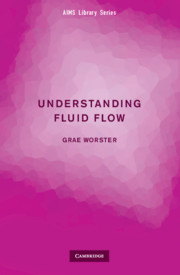7 - Waves and instability
Published online by Cambridge University Press: 30 April 2024
Summary
I shall finish this course with a brief look at surface gravity waves and a particular type of flow instability. First, we need one more central result, as follows.
Energy conservation in potential flow
Bernoulli's equation describes the conservation of energy along stream lines in steady flows. However, a more general statement can be made if the flow is irrotational.We start again with Euler's momentum equation
which, as we have seen before, can be written in the form
If the flow is a potential flow with u = ∇ϕ then ω = ∇ ×u = 0 and the Euler momentum equation shows that
Therefore,
a function of time t only. In other words, the energy density, on the left-hand side of this equation, is uniform in space. We shall now make use of this to analyse water waves.
Waves on deep water
Considerwaves on the surface of a deep layer ofwater occupying y < 0, as illustrated in Figure 29.We shall see from our analysis that the layer can be considered deep (as far as the waves are concerned) if its depth is much greater than the wavelength of the waves. If the surface of the water is deflected to y = η(x, t) then we can solve Laplace's equation
for the velocity potential ϕ.
We can apply kinematic (having to do with motion) boundary conditions
The first of these conditions just requires that the motion of the water decays far below the surface. The second condition, which relates the vertical velocity to the vertical motion of the surface, is an approximation for small surface deflections.
In addition, we can apply a dynamic (having to do with forces) boundary condition that the pressure
where we have chosen atmospheric pressure to be the zero level for pressure variations. We can use energy conservation for potential flow to write this condition as
noting that the pressure is hydrostatic far below the surface, where fluid motions are negligibly small.
The mathematical problem set out above is nonlinear and difficult to solve. Here we shall only consider the behaviour of small-amplitude waves, whose height (measured from a trough to a crest say) is much less than their wavelength. We shall also only consider the behaviour of waves of a single wavelength 2π/k, where k is the wave number.
- Type
- Chapter
- Information
- Understanding Fluid Flow , pp. 83 - 99Publisher: Cambridge University PressPrint publication year: 2009

